- Submitting a case study? Email CaseStudies@DigitalTrainingAcademy.com
- Booking a course? Email Tutors@DigitalTrainingAcademy.com or call +44 (0)20 7244 9661
- Apply for a training needs assessment
Digital marketing industry case study library
Browse case studies by topic
Case studies library
- Case studies
- - Advertising
- - Ecommerce
- - Healthcare and pharmaceutical
- - Mobile marketing
- - Search
- - Social media
- - Sport
- - Travel
- - Viral
- - YouTube
- All other case studies
- Daily digital marketing news
Training services
- In-company training
- Executive coaching
- Marketing courses
- Current participants
- Graduate services
- About us
- Case study library
Consultancy and research
Integrated Marketing case studies: we currently have 59.
Any agency or media owner can submit case studies to our team and these 59 are the strongest we have received, with the most recent case studies at the top of this page. If you're interested in more digital marketing case studies then review our complete case study library. If you're interested in submitting case studies then email our case studies manager to find out more CaseStudies@DigitalTrainingAcademy.com.
Case study: Reebok | Agency: Inside Mobile | Sector: Retail | Format: Mobile
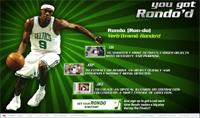 World class strategic thinking, aligned with excellent creative. This is a ground-breaking campaign that sets the standard for what mobile marketing can achieve. Mobile was at the heart of a massive integrated campaign combining advertising, social media and experiential channels, creating discussion and building engagement. Astonishingly, the campaign was all put together in just 8 days.
World class strategic thinking, aligned with excellent creative. This is a ground-breaking campaign that sets the standard for what mobile marketing can achieve. Mobile was at the heart of a massive integrated campaign combining advertising, social media and experiential channels, creating discussion and building engagement. Astonishingly, the campaign was all put together in just 8 days.
Download Reebok Rondo'd case study
07/05/2009 | Full story...
Case study: Skittles | Sector: FMCG | Format: Social media on Facebook
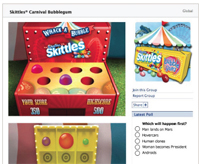 Skittles wanted to introduce and raise brand awareness for its new Carnival Gum confectionery product to teenagers and young adults on Facebook.
Skittles wanted to introduce and raise brand awareness for its new Carnival Gum confectionery product to teenagers and young adults on Facebook.
Skittles leveraged Facebook’s integrated advertising platform to build brand awareness for the new Carnival Gum using a combination of Virtual Gifts, Sponsored Stories and the custom Skittles Carnival Gum Sponsored Group branded destination.
Download Skittles Facebook case study
26/02/2009
Case study: Talk to Frank | Agency: Profero | Sector: Health information | Format: Web graphical formats
 When the UK government’s Central Office of Information commissioned the online elements of their health education campaigns to teach children about the dangers of drugs, they used a sophisticated mix of web formats to encourage interaction and solicit greater involvement. The ‘Talk to Frank’ campaign integrates the web, television, leaflets and face-to-face marketing activities to provide young people with access to detailed information about the specific risks of different drugs. This multi award-winning campaign included placements of banners and skyscrapers that encouraged viewers to take icons from one to the other in order to trigger an action: they could take the image of a drug from the banner to the brand character in the skyscraper and then see how it affected him. The activity delivered the message of the campaign without demanding a click through and as well as the visible skyscraper and banner formats included a rich media layer over the page.
When the UK government’s Central Office of Information commissioned the online elements of their health education campaigns to teach children about the dangers of drugs, they used a sophisticated mix of web formats to encourage interaction and solicit greater involvement. The ‘Talk to Frank’ campaign integrates the web, television, leaflets and face-to-face marketing activities to provide young people with access to detailed information about the specific risks of different drugs. This multi award-winning campaign included placements of banners and skyscrapers that encouraged viewers to take icons from one to the other in order to trigger an action: they could take the image of a drug from the banner to the brand character in the skyscraper and then see how it affected him. The activity delivered the message of the campaign without demanding a click through and as well as the visible skyscraper and banner formats included a rich media layer over the page.
Talk to Frank | Ask your Tutors for more insights | Submit your own case studies
16/04/2008
Case study: ArmyOnEverest.mod.uk | Agency: FitchLive | Sector: Army recruitment | Format : Content creation and event amplification
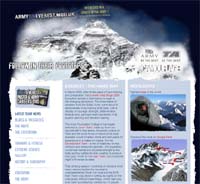 When the Army planned their assault on the West Ridge of Everest in 2006, there was an opportunity to engage young potential recruits by letting that story be told. Climbed only once in 30 years, only one group had ever made it to the top. PCIFitch were supplying the raw materials from the field back into the mainstream media as well as the web. The intention was to touch audiences through streams on the web, podcast downloads, iTunes and the broadest range of touchpoints. Over a million viewers enjoyed streamed content, blogs were posted to the site from the mountain and to feed into the recruitment processes, schools were targeted with lesson plans created for teachers and games for their students. Integration included downloadable posters and images, text alerts and more than a dozen different channels. The campaign went on to win the “Best digital campaign of 2006” at the Campaign awards. When we interviewed Peter Cowie, Managing partner at FitchLive who were behind the work, said “great work comes from the chemistry of the teams working together. The effect of the campaign included attracting 1m people, 30,000 of whom claimed they were ‘interested’ in joining the army. 3,500 are likely to be recruited as a direct result of the campaign”. For Peter it’s clear that “the future of advertising is about using all of these new channels together”.
When the Army planned their assault on the West Ridge of Everest in 2006, there was an opportunity to engage young potential recruits by letting that story be told. Climbed only once in 30 years, only one group had ever made it to the top. PCIFitch were supplying the raw materials from the field back into the mainstream media as well as the web. The intention was to touch audiences through streams on the web, podcast downloads, iTunes and the broadest range of touchpoints. Over a million viewers enjoyed streamed content, blogs were posted to the site from the mountain and to feed into the recruitment processes, schools were targeted with lesson plans created for teachers and games for their students. Integration included downloadable posters and images, text alerts and more than a dozen different channels. The campaign went on to win the “Best digital campaign of 2006” at the Campaign awards. When we interviewed Peter Cowie, Managing partner at FitchLive who were behind the work, said “great work comes from the chemistry of the teams working together. The effect of the campaign included attracting 1m people, 30,000 of whom claimed they were ‘interested’ in joining the army. 3,500 are likely to be recruited as a direct result of the campaign”. For Peter it’s clear that “the future of advertising is about using all of these new channels together”.
15/11/2007
Client: Colgate | Sector: FMCG | Objective: Customer acquisition | Format: Banners
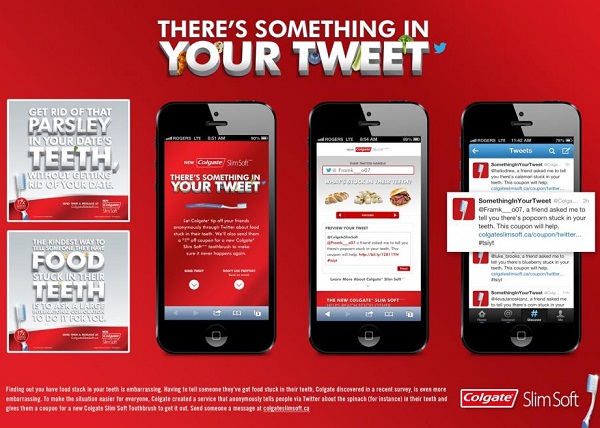 Colgate ran their advertising campaign in print, television and online. The results showed that it cost 23% more to encourage consumer purchase using TV alone compared to using TV in combination with online. For their multichannel campaign, reallocating marketing dollars to online advertising was significantly more cost-effective at driving purchase intent and enhancing key branding metrics. Simply by allocating 7% of media dollars to online, purchase intent increased 3.8%.
Colgate ran their advertising campaign in print, television and online. The results showed that it cost 23% more to encourage consumer purchase using TV alone compared to using TV in combination with online. For their multichannel campaign, reallocating marketing dollars to online advertising was significantly more cost-effective at driving purchase intent and enhancing key branding metrics. Simply by allocating 7% of media dollars to online, purchase intent increased 3.8%.
01/08/2007
Client: VeriSign | Sector: Technology | Objective: Brand awareness, customer acquisition | Format: leaderboards and skyscrapers
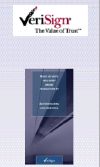 The campaign ran in several business and technology magazines, including Forbes, CIO, Computer World and Network Computing, as well as targeting a B2B technology audience via online sites. The magazine ran one-page and two-page ads of striking black-and-white photos of large building projects, emphasising by analogy the reliability of VeriSign's infrastructure. Online, the ads were graphically similar but simpler, presented in leaderboard, large rectangle and skyscraper formats, with the copy emphasising security services. When readers saw both the magazine and online ads, their awareness, association and purchase intent for the security and directory services raised slightly (3-4 points), as did their impression of the brand as innovative (4 points). As for the white paper downloads, which was half of the measure of the online ads' success, the interactive ads were highly effective in doing so, generating more than 2,000 downloads, which exceeded the campaign's goal, compared to only 16 downloads attributable to the magazine ads.
The campaign ran in several business and technology magazines, including Forbes, CIO, Computer World and Network Computing, as well as targeting a B2B technology audience via online sites. The magazine ran one-page and two-page ads of striking black-and-white photos of large building projects, emphasising by analogy the reliability of VeriSign's infrastructure. Online, the ads were graphically similar but simpler, presented in leaderboard, large rectangle and skyscraper formats, with the copy emphasising security services. When readers saw both the magazine and online ads, their awareness, association and purchase intent for the security and directory services raised slightly (3-4 points), as did their impression of the brand as innovative (4 points). As for the white paper downloads, which was half of the measure of the online ads' success, the interactive ads were highly effective in doing so, generating more than 2,000 downloads, which exceeded the campaign's goal, compared to only 16 downloads attributable to the magazine ads.
01/08/2007
Client: ING | Sector: Finance | Objective: Customer acquisition | Format: Banners
 The objective of the XMOS study is to help marketers and their agencies answer the question: what is the optimal mix of advertising vehicles across different media, in terms of frequency, reach and budget allocation, for given campaign to achieve its marketing goals? This particular campaign for ING ran for six months and included advertising on television, magazines and online. The budgetary proportions of the campaign were 68% for television, 17% for magazines and 15% for the internet. The media mix proved to be more effective than advertising would have been in any single medium. The 15% share of budget that ING assigned to interactive demonstrated itself to be ideal in this campaign.
The objective of the XMOS study is to help marketers and their agencies answer the question: what is the optimal mix of advertising vehicles across different media, in terms of frequency, reach and budget allocation, for given campaign to achieve its marketing goals? This particular campaign for ING ran for six months and included advertising on television, magazines and online. The budgetary proportions of the campaign were 68% for television, 17% for magazines and 15% for the internet. The media mix proved to be more effective than advertising would have been in any single medium. The 15% share of budget that ING assigned to interactive demonstrated itself to be ideal in this campaign.
01/08/2007
Client: Ford | Sector: Automotive | Objective: Customer acquisition | Format: Banners
 Ford has launched a cross media advertising campaign both on English and Spanish TV, radio, print, outdoor and via direct mail and online. The online ads that ran on auto-related pages proved to be the most cost effective at raising purchase intention: the portal roadblock ads and magazine ads were more expensive at raising purchase intention than in-market interactive ads, but they were both a great value in terms of cost-per-impact compared to television.
Ford has launched a cross media advertising campaign both on English and Spanish TV, radio, print, outdoor and via direct mail and online. The online ads that ran on auto-related pages proved to be the most cost effective at raising purchase intention: the portal roadblock ads and magazine ads were more expensive at raising purchase intention than in-market interactive ads, but they were both a great value in terms of cost-per-impact compared to television.
01/08/2007
Agency: Taglab | Client: N&P | Sector: Finance | Objective: Customer acquisition | Format: Web content
 Interactive Flash presentation aids used by financial planners at Norwich & Peterborough Financial Advice Service to inform and educate customers on a variety of topics including attitude to risk, the cost of delay in starting a pension and how the stock market works. In order to provide high quality, impartial advice to an audience who tend to be financially unsophisticated, N&P’s advisors require presentation aids that help them to discuss complex financial concepts such as attitude to risk in a clear and accessible manner. Taglab developed a range of interactive Flash presentation tools that could be integrated into N&P’s electronic financial advise system.
Interactive Flash presentation aids used by financial planners at Norwich & Peterborough Financial Advice Service to inform and educate customers on a variety of topics including attitude to risk, the cost of delay in starting a pension and how the stock market works. In order to provide high quality, impartial advice to an audience who tend to be financially unsophisticated, N&P’s advisors require presentation aids that help them to discuss complex financial concepts such as attitude to risk in a clear and accessible manner. Taglab developed a range of interactive Flash presentation tools that could be integrated into N&P’s electronic financial advise system.
Download Norwich & Petersborough Financial Advice case study | Ask your Tutor for more insights | Submit your own case studies
01/08/2007
Case study topics
- 1upSearch
- 20th Century Fox
- 3
- AA
- Adidas
- advertising
- advertising creative
- advertising spend
- Africa
- AIS
- AKQA
- All Nippon Airways
- analytics
- Android
- apps
- Argentina
- Army
- Asda
- Asia
- Audible
- augmented reality
- Australia
- Autobytel
- automotive
- Avis
- Axe
- banners
- Bayer Healthcare
- BBC
- behavioural targeting
- Belgium
- Ben and Jerrys
- Betfair
- Big Picture
- Blendtec
- Blink TV
- blogging
- BMW
- Bookstart
- brand awareness
- brand equity and positioning
- Brandcast Media
- Brazil
- British Airways
- British Gas
- Bruno
- Burberry
- Burger King
- Buzzfeed
- Cadburys
- Cambria Automobiles
- Canada
- Cannes Lions
- Cannon
- Carling
- Carlson
- CBI
- celebrity marketing
- Centrica
- Channel 4
- charity
- Chemistry UK
- Chile
- China
- click through
- clothing
- Coca Cola
- Colgate
- Columbia
- Compass Interactive
- consumer electronics
- consumer insight
- content marketing
- Creative Lynx
- Crispin Porter and Bogusky
- CRM eCRM and email marketing
- Croatia
- cut through
- Cyprus
- Denmark
- design
- Diageo
- digital companies
- Digital Intelligence
- digital marketing
- Digital Marketing Case Study
- Digital Training Academy
- digital trends
- direct response
- directory
- Dove
- driving traffic
- DTI
- Dynamic Logic
- easyJet
- ecommerce
- eDetail
- education
- EE
- Egypt
- EMEA
- Emirates
- energy
- engagement
- entertainment
- environment
- Europe
- experiential marketing
- Festival
- Fiat
- film
- finance
- Finland
- Fish4jobs
- FitchLive
- Flickr
- FMCG digital marketing
- Ford
- France
- French Connection
- Friends of the Earth
- FuturAd
- g8wave
- gaming and gamification
- Germany
- Gjensidige
- global
- glue London
- Golden Pages
- Google AdWords
- government
- Greece
- Greenlight
- GSK
- H and M clothing
- Habitat
- Halesway
- Handbag
- healthcare and pharmaceutical
- Heineken
- Heinz
- Hewlett Packard
- Hong Kong
- Hong Kong Tourist Board
- Incentivated
- increasing conversion
- India
- Indonesia
- ING
- Inside Mobile
- insurance
- integrated marketing
- interactive media
- Israel
- Italy
- Jaguar
- Janssen Cilag
- Japan
- Johnhson and Johnson
- Johnnie Walker
- JVST
- KDDI
- Kelloggs
- KFC
- Kimberly Clark
- Kleenex
- Kraft
- Kwik Fit
- Lacta
- Langland
- lead generation
- LEGO
- Levis Jeans
- LG
- Life chats
- Lionsgate
- Lipton
- local
- LOreal
- luxury
- Lycos
- M and C Saatchi
- MacMillan
- magazine
- Malaysia
- marketing
- Marketing Evolution
- marketing fails
- Mars
- Mazda
- McDonalds
- Mediacom
- MediaMInd
- Mentos
- Mexico
- Microsoft
- Middle East
- MMA
- mobile marketing
- Monarch
- Mondelez
- Motorola
- MSN
- music
- Nestle
- Netherlands
- NetSupport
- Netthink ES
- New Zealand
- Nike
- Nivea
- Nokia
- Norway
- Norwich and Peterborough
- Nutella
- OgilvyOne
- Oi Media
- online advertising
- online forum
- online media
- online radio
- Oodle
- Oracle
- Oreos
- Outdoor
- Palm
- pay per click advertising
- Pedigree
- Pepsi
- Periscope
- Philippines
- Pixelpusher
- Plumbworld
- podcasting
- Poland
- portal
- Portugal
- Procter and Gamble
- Profero
- publishing strategy
- purchase intent
- Qatar Airways
- QR codes
- R GA
- Radisson Edwardian Hotels
- Random42
- Reckitt Benkiser
- recruitment
- RedEye
- Reebok
- reputation management
- retail
- Revels
- rich media
- Rocksound
- Romania
- Royal Marines
- Russia
- Saatchi and Saatchi
- Sainsburys
- Samsung
- Saw V
- Schering Plough
- Schroders
- search
- search engine optimisation
- security
- Sephora
- Shell
- Singapore
- Skive Creative
- Skype
- Slovakia
- SnapChat
- Snickers
- social media
- Sonaa
- Sony
- South Africa
- South America
- South Korea
- Spain
- sport
- Sprite
- STA Travel
- Starbucks
- strategy
- Stride
- Sweden
- Switzerland
- Sympatico
- Taglab
- Taiwan
- Talk Talk
- Talk to Frank
- targeting
- TBWA
- technology
- technology and software
- Telecommunications
- Television
- Thailand
- The Body Shop
- Tourism New Zealand
- Toyota
- traffic driving
- Transport for London
- travel and tourism
- trend creation
- Tumblr
- Turkey
- TVL
- UAE
- UK
- Unilever
- Universal Pictures
- Universal Studios
- USA
- uSwitch
- Vaseline
- Vauxhall
- VeriSign
- video
- Vietnam
- Vine
- viral
- Virgin
- Visa
- Vodafone
- Volkswagen
- Volvo
- Warner Breaks
- Warner Bros
- Warner Music
- Webcredible
- William Hill
- Windows
- Windows Live Messenger
- Worth
- Yahoo
- youth marketing
- YouTube